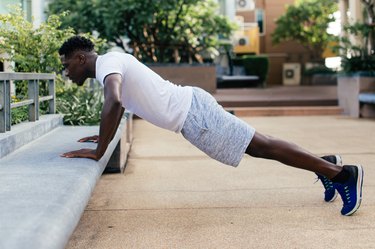
During strength-training sessions, runners tend to solely focus on the legs, glutes and core. After all, they're doing the majority of the work as you pound the pavement. However, you'd be doing yourself a huge disservice if you didn't also make sure to work your arms.
A lot of runners — especially newbies — assume arm strength isn't important for runners, says Michele Yates, founder and director of coaching at Rugged Running. But your arms directly affect everything from your gait to your oxygen consumption, she says, so working on your upper body can help you become a more efficient runner.
Video of the Day
Video of the Day
Why Runners Shouldn’t Ignore Their Arms
Adding upper-body training can optimize — and help offset negative effects on — running economy, according to an August 2019 study from Sports. It all comes down to the kinetic chain, which Cory Smith, owner and head coach at Run Your Personal Best, explains is part of why we shouldn't think of any one part of our body in isolation.
"Our bodies work as a unit; when one joint or limb is moved, such as a forward leg swing, it creates a chain reaction through the entire body affecting all the other joints to help maintain balance and move the body forward," Smith says. "If you have one weak link in the chain, you'll lose energy that would have been used to move you forward."
Your arms are part of that kinetic chain, and while you're running, they help you move through your gait cycle, Yates says. If you've heard a coach or fellow runner talking about driving your arms, it's to help add power to your gait (Yates specifically notes the biceps here, which keep the elbows bent and allow for a more powerful arm swing).
"The more force our legs produce, the greater force is needed in the arms to counterbalance that force," Smith says. "The faster you run, the more arm strength plays a role in helping you run."
Read more: 12 Running Mistakes You Could Be Making
Try This 20-Minute Upper-Body Workout
The ideal upper-body workout for runners — according to Yates and Smith — combines both compound movements (exercises that work multiple muscle groups at once) and isolation exercises that zero in on one muscle used to push and pull your arms during your arm swing.
Smith recommends doing the following workout as a circuit. "Run down the list of exercises in chronological order, back-to-back," he says. Start off with one set and build your way to to 3 to 4 total sets over the course of six weeks.
Once you're doing more than one set, you'll want to take 3 minutes of rest before beginning the circuit again. If you're doing this at home or if you only have access to smaller weights, Smith says to do a higher number of reps.
You can do this workout even on run days, but Smith says that working each muscle group should be limited to two to three days a week. "It is preferred you lift these either immediately following your run or later in the day," Smith says.
Do: 12 to 15 reps of each of the following exercises with 5- to 20-pound dumbbells (except for the push-ups). Rest 3 minutes before repeating the circuit as time and your strength allow.
- Push-Ups
- Lateral Side Raises
- Biceps Curls
- Overhead Triceps Extension
- Dumbbell Shoulder Press
Move 1: Push-Up
- Lie down flat on your stomach with hands under shoulder before pushing your body up into a plank.
- With your palms flat on the ground, your arms should be roughly shoulder-width apart with your shoulders stacked over your wrists and feet either together or hip-width apart.
- Slowly lower your body down by bending your elbows back at a 45-degree angle to your body.
- Press yourself back up to the starting position and repeat.
Move 2: Lateral Side Raise
- Stand with your feet hip-width apart and hold the dumbbells at your sides, one in each hand.
- Bring your arms out and raise the dumbbells up to shoulder height with elbows slightly bent. Your body should form a T.
- Lower the weights back down to your sides and repeat.
Move 3: Biceps Curl
- Grab a dumbbell in each hand, with your palms facing outward and the weights in front of your thighs.
- Moving only your forearms, slowly raise the dumbbells up toward your shoulders, keeping the top of the arms still.
- Again, moving only your forearms, lower the dumbbells back down to the starting position and repeat.
Move 4: Overhead Triceps Extension
- Stand up straight and hold one dumbbell in both of your hands (with hands stacked on the handle).
- Bring your arms up straight over your head, arms by your ears.
- Bending at the elbows, slowly lower the weight down toward your back.
- Raise the weight back up so that your arms are straight overhead and repeat.
Move 5: Dumbbell Shoulder Press
- Stand up straight with feet hip-width apart and hold a dumbbell in each hand.
- Bring your arms up so that your upper arm is level with your shoulder and arms are bent at the elbow, with the dumbbells up near your ears (or above).
- Press your arms straight up into the air, straightening your elbows and almost touching the dumbbells together at the top of the move.
- Lower your arms by bending your elbows, returning them back to ear level and repeat.